On the afternoon of the theatrical première in New York at the IFC Center, Thomas Piper, the director/cinematographer of Five Seasons: The Gardens Of Piet Oudolf, and landscape architect Piet Oudolf joined me for a conversation on Manhattan's High Line Park, the Hauser & Wirth Somerset garden in Bruton, England, and Serpentine Galleries Artistic Director Hans-Ulrich Obrist's reminder that artists go on a Grand Tour.
The enchanting documentary starts out with a mini tour of the Oudolf Garden in Hummelo, Netherlands and then Thomas Piper takes us with Piet to the exquisite wildflowers of West Texas, the forests in White Clay Creek Preserve, Pennsylvania, the planting of the Lurie Garden in Chicago, and a revisit to the Schulenberg Prairie Restoration in Lisle, Illinois. We see Piet at work conceiving the Hauser & Wirth Somerset garden at Durslade Farm, and listen in on a conversation between him and James Corner on the impetus for the High Line Park.
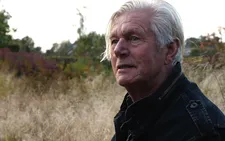 |
| Piet Oudolf on being jolted by the first flowers of the year: "It still happens after so many years. In my work I try to give people an overdose." |
Anne-Katrin Titze: Whenever I see the first flowers of the year, it gives me a jolt. They produce a physical jolt. It's like Proust's madeleine. Usually only smells can produce such a strong reaction. But when I see snowbells and the crocuses, I jump. Every year I become a child again.
Piet Oudolf: That happens to me, too. It still happens after so many years. In my work I try to give people an overdose.
Thomas Piper: Being in New York, we're lucky that we can experience that. I mean the High Line sometimes gets reduced to this idea of it as a tourist destination. People go and see it and no matter when they're going to see it, it's beautiful.
But for us, for people who are here and are able to go throughout the year, it's really magic. Because you can actually see what happens from time passing. For me, I love the moment too when it's all there and then the cutback happens and then it's all gone. It feels very extreme.
PO: Everything that you felt was so beautiful is suddenly gone.
AKT: It makes you realise.
PO: That it's not a landscape. So you suddenly miss that content of everything around you. But also the context can be beautiful. I mean the woodland in the back, or your house or your farm. That's also what you mean. In gardens there's also always a backdrop. Suddenly the city refills.
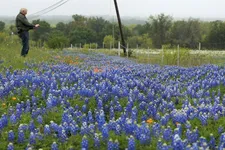 |
| Piet Oudolf photographing the wildflowers of West Texas |
AKT: It reveals itself. Another issue in this context are the people. I remember having that thought for the first time in the Jardins de Bagatelle in Paris and I noticed how ugly the tourists were dressed and how it annoyed me that they couldn't take into account where they were going.
You go to look at roses and you dress to compete with the flowers and ruin them for the other guests? I was furious that they didn't respect the flowers, nor the other people. I remembered that watching the film. You always dress so beautifully and appropriately to the garden.
TP: He's a style icon.
PO: I'm not really fashionable. Just simple clothes, I think. We have friends in the fashion world. We always were interested in fashion. But it's not that we dress fashionable but you probably feel that a little bit. Also the way we do our house and so on. I dress very casual.
AKT: Do you dress for the garden?
PO: If you're gardening, it takes so much time. The last ten years or so it's more for me to look at it and see the processes. It's for me as important. That is also gardening. With your eyes.
AKT: Near the end of the film we see the Hauser & Wirth garden in Somerset come to life. It's like a baby. That's the vocabulary you're using. "It's screaming and crying."
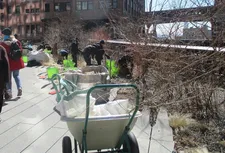 |
| Workers planting in High Line Park at the end of a New York winter Photo: Anne-Katrin Titze |
PO: Oh yeah. Those terms came up so unexpectedly. I've never used them before in that sense.
AKT: It's perfect because that's what babies do and the plants are competing. I think it's in Texas when you discuss the issue of native plants and non-native plants?
TP: That was in Chicago, yes.
AKT: And you say, well, as long as it shows some respect for the other plants, it's fine.
PO: It's true. Also in our communities. You call this a country of natives? No! It's a country of non-natives. The few natives there are, they're struggling for their properties. We started the idea of using more natives, combined with non-natives. It became for me a sort of habit.
Because there are many natives that look good and behave very well and are very good in association with non-natives. They benefit. They come from the same habitat. But then when my gardens became more well-known, suddenly I felt that it became a platform for people that were always fighting for 100% native plants. I became a bench for them to come into the world. That's sometimes what I think, over 30 years.
TP: What I find interesting, certainly in the making of the movie, trying to raise money for the movie, there's so many aspects of your work that speaks to different groups. There's the whole sort of art world connection. That they found you and that it works in that context.
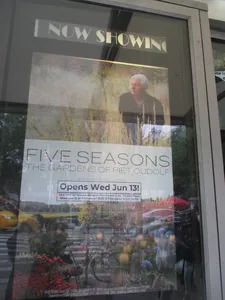 |
| Five Seasons: The Gardens Of Piet Oudolf poster at the IFC Center Photo: Anne-Katrin Titze |
Then there's the ecological and specifically the native plant context. People were able to sort of grab on to it. But you're not working to serve a particular dogma. You're just working for yourself.
PO: It's nice that I've been supported by many people but I'm one of the few that really wanted to work and saw plants as a tool to express myself. Most people see a plant as an individual and a beauty and a nice combination and a garden. But I needed it just so that I can do something with it. It's more than just putting plants together.
AKT: The whole issue of non-invasive species has reached ridiculous proportions here. The plan of getting rid of all Mute Swans in New York State because they are not native and came here in the 1890s.
PO: Ridiculous, yeah.
AKT: Hans-Ulrich Obrist talks about artists going on a Grand Tour. Did that inspire you to go on a Grand Tour together?
TP: Well, the interview with Hans was actually one of the last things I shot.
AKT: Okay, the opposite.
TP: It was the opposite. But the idea, I thought it was really nice the way he put it. It was always interesting to me that it's a path of finding something. You know for Piet of finding an outlet for the need to create that lead to plants.
And even the idea of - and that's not something that's celebrated as much, but the idea of dedicating yourself to acquiring knowledge instead of being just fully formed in your 20s, or something. So if you spend an enormous amount of time in the nursery in Piet's case …
PO: Plants are a complex matter. To understand plants and what they do, I still don't know. It takes your whole life. That's why you know after 30 years at least I do it better than someone who has done it for 15 years. Understanding is more working with them and trying.
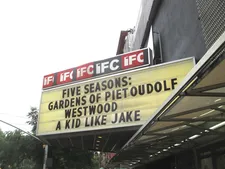 |
| Five Seasons: The Gardens Of Piet Oudolf on the IFC Center marquee Photo: Anne-Katrin Titze |
And not every garden is the right habitat for the plant. You also have to work with the tolerance of plants. Because plants can tolerate. We have plants that come from wetlands and we can still have them on the High Line, which is not wetland at all. But you know, you play with possibilities. It's not really 100% habitat right or ecologically right. Plants are so tolerant that they take it.
AKT: Just as we are.
PO: For me it's also to show people what you can do with plants for your environment and what it does to yourself. So as long as you can touch people with what you do, whatever you do, making film, making music, it does something to the society.
AKT: Your work did make me think about the different layers of time, the different ways we approach time. Circular time and the knowledge you have what a plant will be like in a certain amount of time. Was time a central issue for the film?
TP: For sure. To see the gardens over a full year, the time-lapse things that I tried to do, it was all trying to somehow … Watching plants grow is not inherently exciting. So there had to be some way to sort of capture what is dynamic about it and those were all the ways.
PO: To make it clear how the changes go. In a way that you not normally see a time lapse. It's also shocking going from one to another.
TP: But also feel the mood of the garden which isn't frenetic. So everything had the right mood and feel but also hopefully show people what does happen and make people think about time.
Coming up - Piet Oudolf and Thomas Piper on the sounds of a garden, the change of the seasons, Indian Summer time, anticipation, the performances of plants, and what Piet's gardens convey.
Five Seasons: The Gardens Of Piet Oudolf is in cinemas in the US.








![Thomas Piper with landscape architect Piet Oudolf, who curated the species plant palette for the High Line Park in New York, designed by James Corner's Field Operations and architects Diller Scofidio + Renfro: "For people who are here and are able to go throughout the year [to the High Line], it's really magic. Because you can actually see what happens from time passing."](/images/newsite/Thomas_Piper_Piet_Oudolf_600.webp)













